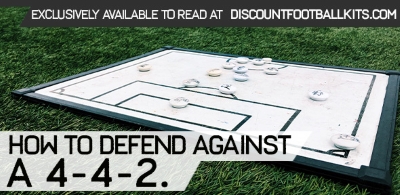People almost talk about the iconic 4-4-2 formation with a sense of nostalgia, with this having become less commonplace in an age where midfield dominance and the deployment of fluid attacking lines take precedence.
However, this shape has enjoyed something of a resurgence in Spain’s La Liga, while Aston Villa manager Unai Emery has also bought this tactical setup back to the Premier League.
Of course, one criticism of the 4-4-2 is that it’s too easy to play against and counter. But what the best ways to defend against this shape and gain a tactical advantage? Let’s find out!
1. Consider Playing a 4-5-1 or 4-3-3 Shape
If your side has technical players with a good range of passing in the middle of the park, you may want to overload this space and create a semblance of midfield dominance.
You can do this by playing a 4-3-3 or 4-5-1, or transitioning between these two shapes when attacking and defending. This immediately gives you a numerical advantage in the middle of the park, which can be exploited when playing a short passing game and looking to play through the centre of the pitch.
What’s more, your wide forwards can also play deeper and tighter to their respective touchlines when out of possession.
This enables them to defend the wide areas and negate potential overloads on the flanks, while these players can move inside and threaten the penalty area during attacking phases.
2. Position Players Between the Lines
The 4-4-2 creates a rigid structure for the teams that use it, establishing two clear defensive lines that the opposition has to play through.
However, being too rigid can be challenging when playing against sides that have significant movement and strive to pass the ball quickly.
Similarly, the 4-4-2 can be undone by deploying players between the lines of the defence, midfield and attack. For example, if you play a 4-2-3-1 or 4-4-1-1, you can deploy a split or deep-lying striker who’s able to find space in the attacking third and pull opposing players out of position.
You could also use a sweeper or deep-lying midfielder in your formation, in order to afford additional defensive security and cover against two opposing central strikers.
3. Opt for Ball-Oriented Pressing
If you like to deploy a high press, consider doing this in a ball-orientated manner, rather than focusing on the specific location of individual players.
With this approach, one or two of your best pressers should focus on squeezing the ball as it’s shifted across the backline, moving with intensity and aggression.
The non-pressing, supporting players should then shift into a player-focused marking shape, minimising the passing options for your opponents in the defensive third.
This will help you to win the ball back quickly and aggressively, while preventing opponents in a 4-4-2 shape from settling in possession. This also prevents teams using a 4-4-2 from hitting their central strikers and potentially creating their own overloads in the attacking third of the pitch.










